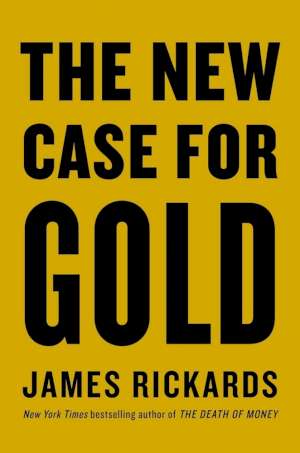28 June 2016
The New Case for Gold
James Rickards
2016, Portfolio Penguin, 182 pages,
Reviewer: Jill Leyland, Formerly Economic Adviser, World Gold Council

I started to read this book with trepidation. James Rickards, as his previous books – Currency Wars and The Death of Money – show, is one of those gloomy predictors of global financial collapse. Rickards, though, does not seem at first sight to be one of the wilder proponents of this. His expectation of financial collapse is not ‘apocalypse now’ but more something like the collapse of Bretton Woods in 1971 – in this case he sees a major decline in the dollar and the end of its hegemony coupled with financial panic. His view may be more extreme than most, but dollar hegemony will end one day and no-one can say that we have solved all the problems that led to the 2007-08 financial crisis. What lets the book down, in my view, is muddled argument, exaggeration and Rickards’ limited understanding of the gold market, which leads him to some questionable conclusions.
The book starts off fairly promisingly. Rickard takes the classic ‘anti-gold’ arguments one by one arguing that they are mainly false. He points out that Keynes’s famous ‘barbaric relic’ quote referred to the interwar gold standard not the yellow metal itself; Keynes’s actual view of gold was far more nuanced. He highlights all the research showing that gold did not cause the great depression of the 1930s but shows that the dysfunctional way that the gold standard was used in the 1920s and 1930s was part of the problem. He is on weaker ground when he tries to claim not just that there is enough gold to support the international monetary system (arguably true if the gold price were high enough) but also that the increase in gold production, if gold were to be so used, is sufficient to support global growth.
After that the book becomes patchy at best. There is a useful section on the physical properties of gold compared to other elements that shows why gold became the supreme money in the past. And he points out the numeraire problem due to always thinking of the price of gold in dollars. But much of it is muddled, relying on assertion rather than argument – and some rather far-fetched assertion at that.
Depressingly, after earlier dismissing the conspiracy theories that say that the gold in Fort Knox has been secretly sold off to keep the gold price lower than it should be, he then argues that the gold selling by central banks and monetary authorities from the 1970s to the millennium was an effort to manipulate the gold price. When his prediction of financial panic and collapse occurs, he argues, the world is likely to look to a gold standard or gold-based currency system sending the gold price soaring. And it is anticipation of that day that is behind countries such as Russia and China increasing their gold reserves so they have a ‘seat at the table’. The gold price (at the time of writing around $1,250 to $1,300 per troy ounce) will soar to $5,000 or even $10,000. Really?
Arguably there was an attempt to write gold out of the system in the 1970s (including the passing of an IMF article stating that member countries could not link their currencies to gold). But central bank selling in the 1990s was due either to a perception that gold had had its day or to a perfectly reasonable wish to reduce an overweight percentage of gold in a reserve portfolio. Financial panics do have a positive effect on the gold price and central banks as a whole, including Russia and China, are currently net buyers of gold. Only the most blinkered would now argue that gold’s monetary use is entirely past but it takes a takes a gigantic leap of faith to move from that to Rickards’ prediction. Or to the argument that Russia and China need to buy gold in order to have influence in any future debate on the monetary system.
Rickards also overlooks the role of jewellery in gold. As part of his general argument that China and others are increasing their gold holdings, he quotes a visit to a Zurich refinery in 2013 which was working flat out producing one kilo gold bars largely for the Chinese market from any available source. Sadly no one told him that the type of bar he saw produced is used primarily by jewellery manufacturers and that 2013 saw a huge surge in Chinese jewellery demand and manufacture.
But the saddest thing about this book is that it ignores much of the real case for gold in today’s world. There is little reference to the research showing its diversification benefits for many investment or central bank portfolios (including during periods of financial turmoil) or of the way it can limit a portfolio’s downside risk. It is this research, coupled to its performance in times of turmoil as well as the more traditional arguments such as the fact that it is no one’s liability, that is the real case for gold today.
